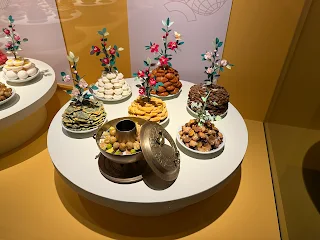A Lunchtime Encounter with the Flavors of the Joseon Dynasty: A Visit to the Special Exhibition 'Royal Cuisine: A Table of Respect and Sharing' at the National Palace Museum of Korea
Royal Cuisine: Embodying the Philosophies of Respect and Sharing
Taking advantage of my lunch break, I visited the special exhibition ‘Royal Cuisine: A Table of Respect and Sharing’ currently being held at the National Palace Museum of Korea. This exhibition sheds light on the social values and philosophy of the Joseon Dynasty through its royal food culture. It runs from November 20, 2024, to February 2, 2025, in the Special Exhibition Gallery on the 2nd floor of the National Palace Museum of Korea in Jongno-gu, Seoul.
The exhibition showcases the essence of Joseon Dynasty royal cuisine through around 200 artifacts, along with recreated models of the food from that time and video materials. The royal food culture was not just about food but embodied the philosophical values of respect and sharing, which served as a medium to convey comfort and joy to the people and the vassals.
Exhibition Structure: The Essence of Joseon Dynasty Royal Cuisine
This exhibition is composed of two main sections. The first section illustrates the process of how regional specialties from the eight provinces of Joseon were delivered to the royal court and used in the preparation of royal cuisine. In particular, I found the paintings depicting the royal chefs (known as "Suksu") busily preparing food and the cooking utensils used in the royal kitchen to be very interesting. In addition, the exhibit provides a detailed explanation of the process of how food reached the King's table for his daily meals (called "Surasang"). Through this, I could glimpse the devotion of the people and the strict standards of the royal court.
The second section focuses on the culture of royal banquets. The recreation of a "Goimsang" (a table setting with food piled high) used at the banquet commemorating the 30th anniversary of King Gojong's enthronement was particularly impressive. This section introduces not only banquet food but also ancestral ritual food, emphasizing that the royal food culture extended beyond the realm of mere gastronomy to a practice of filial piety and respect.
Hands-on Content and Modern Sensibilities
Beyond simply displaying artifacts, the exhibition space was rich in interactive elements. In a space that recreated a palace kitchen, a video showed water boiling in a cauldron and a ladle stirring. There was also an interesting interactive corner where visitors could compare their own food preferences to those of kings. Additionally, media art and various video content on the theme of royal cuisine added a modern touch and enhanced visitor engagement.
Reflections from the Special Exhibition
This exhibition was a great opportunity to not only look back at the past but also explore the roots of Korean food culture, which is represented by K-food today. In particular, the storytelling approach and interactive content provided by the exhibition were very inspiring. I could feel the intent of the National Palace Museum of Korea to effectively communicate the little-known culture of royal cuisine to the public through this special exhibition.
In Conclusion...
Although I only visited for a short lunch break, I was able to rediscover the deep meaning and value of Joseon Dynasty royal cuisine through the exhibition. If time allows, I would like to visit again and examine more details. If you want to spend a relaxing time near Gwanghwamun while feeling the history and culture, I highly recommend visiting the special exhibition ‘Royal Cuisine: A Table of Respect and Sharing’ at the National Palace Museum of Korea!







